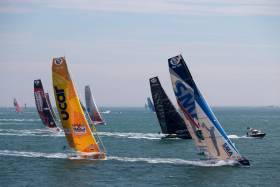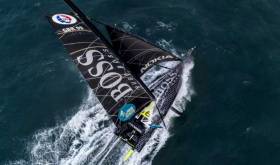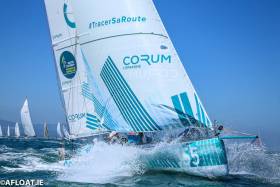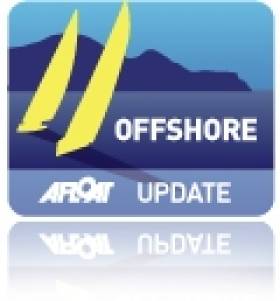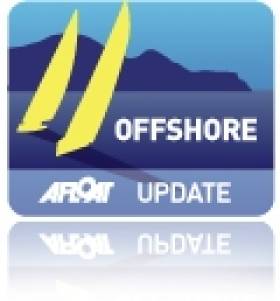Displaying items by tag: Route du Rhum
2018 Route du Rhum Gets Underway in Spectacular Fashion
The 11th edition and 40th-anniversary staging of the Route du Rhum-Destination Guadeloupe solo transatlantic race got underway in spectacular style today off the Brittany port of Saint Malo, as a record entry of 123 skippers set sail for Guadeloupe.
Conditions could not have been better for spectators and sailors alike as the fleet revelled in 20 knots of breeze coming off the land on a beautiful Autumn afternoon.
After a very conservative start with no one wanting to be over the line early at the beginning of a 3,542-nautical mile course, the fastest boats quickly opened up the throttle.
At the front of the fleet the awesome ULTIME trimarans, led by Seb Josse on Maxi Solo Edmond de Rothschild, were hitting 30 knots of boatspeed.
The fastest racing yachts on the planet were soon flying their windward hulls as they rampaged towards the mandatory gate off Cap Fréhel – 17 miles from the start – where thousands of spectators were gathered on the headland.
Among those in their wake were the leading IMOCA monohulls showing their paces with foils lifting the boats from the water as they sped westwards led by France’s Vincent Riou on PRB.
In their wake came the huge 53-strong Class40 monohull fleet at the start of what will be the most competitive race in that class’s history.
Near the back, holding ninth place in the Rhum Multi fleet, was the hugely popular French sailor Loïck Peyron at the helm of the bright yellow Happy. This is a sister ship of the small trimaran sailed by Canadian yachtsman Mike Birch when he won the inaugural Route du Rhum in 1978.
Four years ago in this race, Peyron set a new outright record of seven days and 15 hours on the maxi trimaran Banque Populaire and the routing predictions for this race suggest that that benchmark could be lowered by as much as two days by the leading ULTIMES.
But before they can enjoy a fast ride to the Caribbean in the trade winds, all the sailors will have to face some very rough weather that is coming their way on Tuesday.
The predictions are for big seas, 35-knot winds gusting to 55 knots and a weather picture showing very unstable conditions for most of the rest of the week.
It is thought that some of the skippers in the slower classes will decide to head for refuge in ports west and south of Saint Malo – like Roscoff or La Rochelle – and prefer to wait for the weather to ease, rather than risk damaging their boats early in the piece. Race rules permit them to make a stop of this kind without penalty.
At the gate at Cap Fréhel the fleet leader was Josse who is awarded the Trophée du Cap Fréhel Banque Populaire Grand Ouest. But he had François Gabart in MACIF on his tail with Armel le Cleac’h in third place not far behind on Maxi Solo Banque Populaire.
The next group to pass the gate were the Multi50s where the trophy went to Armel Tripon on Réauté Chocolat followed by Thibaut Vauchel Camus on Solidaires en Peloton Arsep and then Erwan Le Roux on FenêtreA–Mix Buffet.
In the 20-strong IMOCA class Riou was still setting the pace on his orange PRB, now fitted with foils, with his fellow countryman Jérémie Beyou second on the brand new Charal and then Boris Herrmann’s Malizia II – Yacht Club de Monaco in third place.
In Class40s, meanwhile, the race to Cap Fréhel was led by Antoine Carpentier on Beyond the Seas with Nicolas Troussel on his tail on Corum followed by Kito de Pavant on Made in Midi.
In the build-up to the start the upcoming weather was the big talking point, especially for the slower classes who face a very rough time as they try to head west across the Bay of Biscay. But Michel Desjoyeaux, the two-time Vendée Globe winner who is not taking part in this race, said his own routing analysis suggested the weather picture suggested the outright record is destined to fall.
"For the ULTIMES we need to see how they get through the strong stuff, and if they can get through before the really bad weather,” he said. “But even if I am conservative about the sea conditions at the beginning, I have run a route and they could reach the north of Guadeloupe in five days and five hours, so I think the record is almost certain to fall."
Marcel Van Triest, the router for Armel Le Cleac'h, said the ULTIMES should escape the worst of the weather. “They will be ahead of it before it gets bad,” he said. “It will be interesting to see what happens at Ushant at the Traffic Separation Scheme; that will be the first thing and there could be a big separation there immediately. That largely dictates if you go north or south. They should be at the latitude of Spain/Portugal by Monday at 6pm depending how long they stay on port tack.”
In the Class40 fleet, British sailor Sam Goodchild at the helm of the Netflix-sponsored Narcos Mexico said he will not be joining those who decide to ride the worst of the weather out in port.
“It looks like a complicated first week,” he said. “And there are a few people talking about stopping, including some of the top guys, which adds to the general pressure. But personally, I am preparing to race to Guadeloupe. The option is there. I don't want to start thinking about stopping and then continuing because then you are not ready for anything. The problem is that you really need to go quickly in the first 24 hours as the rich get richer, so you have to keep the pedal to the metal.”
Thomas Coville on the multi-coloured Sodebo Ultim said the way to head west this time is to head north first. "I feel pretty good,” he said as he prepared for the start. “The weather is much the same as yesterday. It will be cool and calm for the start, very fast and as soon we get clear of Brittany it will be tough. There is only one way to go and that is north, for once not south. It is going to be tough."
Not Tipped Alex Thomson Has 'Best Optimised IMOCA' for Route du Rhum-Destination Guadeloupe
Alex Thomson will start the Route du Rhum-Destination Guadeloupe solo transatlantic race on Sunday 4th November armed with what, in Hugo Boss, he considers to be the fastest, best-optimised IMOCA 60 in the race's record-sized fleet of 20 boats.
He has the experience of back-to-back podium finishes in consecutive Vendee Globes, sailing's pinnacle solo race, but still the 44-year-old British skipper is not tipped by French experts as a favourite to win this 3,542-nautical mile race from Saint Malo in Brittany to Guadeloupe in the Caribbean.
Welshman Thomson, who was schooled in County Cork and, who, with Manager Stewart Hosford, were Afloat.ie Sailors of the Month, last January, is part of an international line up for this year's race that sadly does not include any Irish entry.
"It does not bother me what the perception is in France," a relaxed Thomson said in Saint Malo aboard his race boat. "I have had a reputation for being a maverick and I used to love it and there were times when I used to hate it. But now, it does not bother me. I don't really care. At least people think I am too fast rather than too slow."
For many years Thomson was considered the outsider in IMOCAs, a hothead racer who pushed too hard and broke too many boats. Then, in the 2016-17 Vendee Globe he pushed winner Armel Le Cleac'h all the way to the finish, despite having broken a foil less than two weeks into the 74-day contest.
As Thomson bids to win the Route du Rhum-Destination Guadeloupe at his first attempt at the race after 15 years in the IMOCA class, his French rivals are according him plenty respect, even if the commentariat of French sailing do not.
Chief among them is Jeremie Beyou who finished third behind Thomson in the last Vendee Globe and who's Charal is the only latest-generation foiling IMOCA to have been launched since the last race.
Just along the race dock from Thomson, Beyou, a three-time winner of the Solitaire du Figaro who was part of the Volvo Ocean Race-winning Dongfeng crew, spoke of his admiration for his British rival.
"Alex's will be the team we are watching closest as we move towards the Vendee Globe," Beyou said. "I think his new boat will be a similar philosophy to mine; you need to have a quick downwind boat, but right now Alex is my closest rival. He has the money, the experience now and he is so very highly motivated to win. I think he can push the boat very hard and is fast.
"On my side, doing the Volvo was a big step because you really have to push hard; you have to remove that part of your brain that holds you back and just get on with it and push. I have definitely changed. Alex maybe had that quality already before and so maybe we are converging in our approach a bit.
"And I adore what he does for the class globally," added Beyou. "He is a great ambassador for this sport of extreme solo sailing and he puts it in front of a big global audience and that is what we want. And as a sailor he has matured and is better able to regulate his pace. Before, in France, we would call him a hothead or speak about his foot which was too heavy on the gas, but in the last two Vendee Globes he has more than proved himself."
Beyou jokes: "Solo sailing was supposed to be a French thing but Alex is making it otherwise."
The race was first held in 1978 and in its 40th anniversary year, the race is celebrating record entries with 124 male and female skippers in six classes taking to the start line on November 4, 2018.
More on the race here
Route du Rhum Boasts Record Class 40 Fleet including Round Ireland Race Competitor Nicolas Troussel
The largest fleet in the Route du Rhum 2018 – the solo transatlantic race that starts from St Malo on November 4th – is the Class 40 monohull division with 53 sailors taking part that includes Nicolas Troussel, the French entrant in this Summer's Round Ireland Race from Wicklow.
This record entry, that makes up almost half the total 123-strong fleet in this four-yearly classic, includes men and women from 10 nations sailing a variety of boats designed within the parameters of what has become an extremely successful class rule.
The Class 40 record for the 3,542-nautical mile course to Guadeloupe in the French Caribbean was set by the Spanish yachtsman Alex Pella with a time of 16 days, 17 hours and 47 minutes in 2014. The best in the class this time will be looking to challenge that, though only the very latest designs sailed by experienced solo ocean racers are likely to do so.
With the exception of the Mini-Transat – a solo transatlantic race sailed in smaller boats - no single ocean race has seen so many entries in one class as this Class 40 fleet for this, the eleventh staging and 40th anniversary edition of the Route du Rhum-Destination Guadeloupe.
The 53 contenders who will take the same startline on November 4th, include no less than three former winners of La Solitaire du Figaro (Kito de Pavant, Nicolas Troussel, Yoann Richomme), not to mention sailors who have already participated in the Route du Rhum-Destination Guadeloupe (Sam Goodchild, Nicolas Jossier, Claire Pruvot, Halvard Mabire) or those who have raced in the Transat Jacques Vabre or The Transat (Maxime Sorel, Antoine Carpentier, Louis Duc, Arthur Le Vaillant, Aymeric Chapellier, Bertrand Delesne, Loic Fequet, Arthur Hubert, Hiroshi Kitada, Robin Swamp, Miranda Merron, Olivier Roussey, Phil Sharp).
Sir Robin Knox-Johnson Claims Third In Route Du Rhum
#RouteDuRhum - Sir Robin Knox-Johnson has surprised even himself by claiming a podium place in the Route du Rhum transatlantic offshore solo sailing challenge.
The 75-year-old sailing legend completed the more than 3,500-mile course from St Malo in Brittany to Guadeloupe in the Caribbean in less under 20 days and eight hours, taking third place in a fleet filled with world-class solo sailors.
"I didn't expect to get on the podium when I started the race," said the Clipper Round the World Race founder, as reported by the Independent.
But as he found himself towards the front of the pack, in spite of his older and heavier boat, he "got competitive and that was tiring. It came down to boat speed.
"She's a fast boat I've got," he added, referring to his 60-foot yacht with the charmingly self-deprecating name Grey Power.
The Independent has more on the story HERE.
#routedurhum – It has been a dramatic night with 15 incidents across the classes, including a collision between an Ultime trimaran and a cargo ship, the air rescue of a sailor after his boat lost its keel and overturned, and a Multi50 sailor who is awaiting help after his float broke off.
Thomas Coville saw his hopes of winning the Route Du Rhum vanish during the first night of the trans-Atlantic race when he damaged his yacht in a collision with a cargo ship.
Competing in the Ultimate class, the skipper of Sodebo Ultime escaped uninjured but damaged the starboard float on his boat.
Coville, who won the 3,542-nautical mile (6,560-kilometer) leg between Saint-Malo and the French Caribbean island of Guadeloupe in 1998 in the monohull class, was among the favorites for this year's race.
Another French skipper, François Angoulvant, had to be rescued after his Class 40 Team Sabrosa lost its keel. Angoulvant was airlifted to Brest where he is in good condition, according to race organisers.
Loick Peyron was leading the field early Monday aboard Banque Populaire VII.
Clipper Race chairman and founder, Sir Robin Knox-Johnston, has sent his first blog since he started Transatlantic solo race, the Route du Rhum - Destination Guadeloupe yesterday at 1400 CET from Saint-Malo, France.
With winds of 30 knots plus and large seas reported overnight, Sir Robin sent this report from his Open 60, Grey Power, this morning.
A grey sea, overcast, light drizzle and a West South Wester'ly Force 5 greeted me at dawn this morning. I am currently 40 miles from Ushant and debating whether to take the inner side of the Traffic Separation zone. Currently making 6-7 knots. Could do more if I put up more sail but we'll stay like this for the time being, as the wind is still 20 plus knots and gusting higher, just had one of 29 knots and the sea very lumpy.
It's a long race, and no point in breaking things at the beginning. I made a very cautious start. My Clipper Race colleague Simon Johnston was with me until half an hour before when my Rhum class competitor Bob Escoffier sent his rib to take him ashore. He has been invaluable, as was fellow colleague Alex Dower.
I soon found myself surrounded by 40's most of yesterday evening, pushing hard. Those boats are quick, but when the forecast squalls of 40 knots arrived I would not have wanted to be in one. Fortunately I had decided to settle in on the first night, so already had 3 reefs in the main and the storm jib set, but the boat was still pushed hard over and even with the mainsail pushed right down its track, was crashing into the waves.
I saw a couple of Automatic Identification Scheme targets turn round, I think they were in the race, but it was a gear breaking situation if you did not think of the boat and try to get her comfortable. We came through without damage, except for the staysail sheets becoming amorous, and it took a dark, cold wet hour on the foredeck, often under water, sorting out the resulting snakes' honeymoon.
Now typing this on a jumping boat is far from easy, as the computer often skips a letter or inserts one you did not ask for.
I am wondering how the big multis are fairing and if everyone is alright. There was some mention on Channel 16 last night but it was in fast spoken French.
C'est tout pour le moment.
RKJ
Solar Sail Yacht Sets Off With Route Du Rhum Fleet Tomorrow
#SolarSail - Ahead of the start of this year's Route du Rhum offshore race, UK Sailmakers gave a special preview of their state-of-the-art solar mainsail that will get its first proper sea trial on board the IMOCA 50 yacht Martinique Challenge.
As previously reported on Afloat.ie, the revolutionary new sail uses the French-designed SolarCloth System, whereby photovoltaic cells are woven into the fabric in a flexible film – allowing whatever boat hoisting it to generate power from the sun, even without direct sunlight.
The SolarCloth System has been specially designed for offshore races such as the Route du Rhum, so it will be interesting to see how the technology performs when the Martinique Challenge sets sail from Saint-Malo tomorrow with a fleet that includes an Open 60 piloted by the legendary Sir Robin Knox-Johnston.
Sir Robin Knox-Johnston On The Solo Transatlantic Race Line
#routedurhum – Clipper Race founder Sir Robin Knox-Johnston, 75, is carrying out final preparations on his yacht Grey power ahead of his return to competitive solo racing in Sunday's Route du Rhum – Destination Guadeloupe race start.
The oldest competitor in the French solo Transatlantic race has had a busy week on board his Open 60 yacht in Saint Malo, Brittany. The media spotlight has been upon Sir Robin with many interviews taking place, and he was also given the medal of the honour of the City of Saint Malo by the Mayor.
Sir Robin is now doing last minute victualing and will spend time with family later. The course and safety briefing took place on Thursday and the final weather briefing will happen Saturday.
"There has been an incredible atmosphere here in the race village all week with hundreds of thousands of visitors. It is great to be back here 32 years after I first did my Route du Rhum race.
"I have enjoyed seeing friends and fellow competitors including Loick Peyron and Francois Gabart. Now I am ready to go and can't wait to get out there. I will be taking it easy as far as Cap Finisterre while I negotiate the shipping lanes, and then I will start to race harder."
Sir Robin will leave the basin at Saint Malo at 0230 GMT for a 0300 lock on Sunday ahead of the 1300 race start.
After enjoying sailing with Clipper Race crew in the 2013 Rolex Sydney Hobart Yacht Race which formed part of the circumnavigation, Knox-Johnston decided to return to competitive solo racing.
Sir Robin had become jealous of watching his Clipper Race crews sail off at the start of new legs during their round the world voyage.
Knox-Johnston created the Clipper Race in 1995 to provide a platform for anyone of any age and any walk of life to experience the thrill of ocean racing and for many, a circumnavigation.
"The great thing about ocean racing is that you can do it at any age, and that's what I want to prove through my participation. In my head I feel 48. I feel younger and fitter than most and am ready to race," Sir Robin added.
He is racing in the same boat he sailed round the world in during the 2006/7 Velux Five Oceans Race, aged 68.
The biennial Clipper Race event has inspired more than 3,000 amateur sailors to compete in what is now the longest ocean race around the planet at more than 40,000 miles since it was established in 1996.
Sir Robin is the only British sailor to have won 'Yachtsman of the Year' three times. He has sailed around the world four times, twice solo, including the Golden Globe historic circumnavigation in 1968/69, and once winning the Jules Verne Trophy in 1994. He last competed in the Route du Rhum in 1982, on the 70-foot catamaran Sea Falcon.
Solo Sailing Conference Offers Charter of Performance Yachts
Irish solo sailing fans may be interested in the annual Solo Racing Festival at the Royal Southern Yacht Club, Hamble on Saturday 12th March.
Given the Figaro race is coming to Dun Laoghaire in August a talk on the Artemis Academy with John Thorn (Figaro 2) will be of particular interest.
Owen Clarke's designer Merfyn Owen, who lives in Hamble will be attending as well as colleagues from their brokerage partners Boatshed Performance.
So whether your interest be solo sailing or short-handed sailing in general they will be there to answer questions on design, construction, as well as sale/purchase and charter of offshore performance yachts.
The Race Fair is an open house from 10.00 for race organisers to meet and greet potential skippers from; Global Ocean/Class 40, Mocra, UK mini group, RORC, SORC, Biscay Challenge, AZAB. Floating boat show, 8 boats including the OC class 40, 2 minis, A35, J105, Figaro 2, Sunfast 3200.
There is a Book Signing, Alex Bennett signing copies of High Seas High Stakes and showing Fuji DVD Mike Golding is opening the talks at 11,00.
Followed by:
Winning Mind Set with Ian Brown, sports psychologist
Global Ocean race with Oliver Dewar
Two Star/Ostar with John Lewis, RWYC
30m trimaran design with Nigel Irens (Idec, Sodebo)
Artemis Academy first term report with John Thorn (Figaro 2)
Route du Rhum with Marco Nannini, (class 40)
all in the spendid riverside setting of the Royal Southern Yacht Club, Hamble.
More HERE.


























